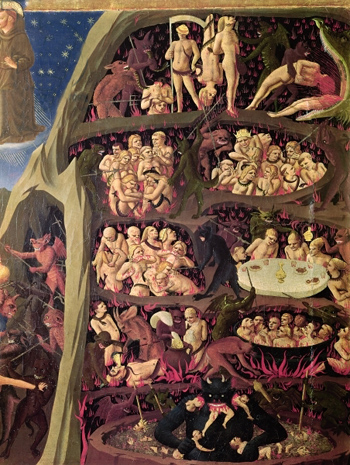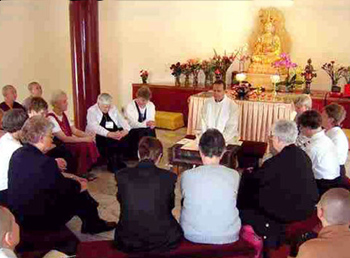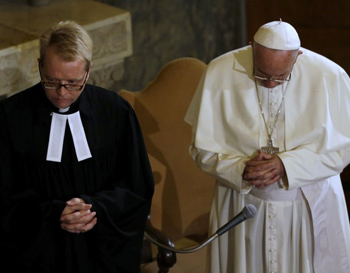New Teachings Lead to Alterations of the Faith
Robert P. Banaugh, Ph.D.
In the last article we looked at some of the teachings in Scripture that contradict the call for mercy that has been made in the post-conciliar Church. Let us look now at more words of Our Lord affirming the right of the faithful to hear the truth:
The right of the faithful to receive the true teaching of the Faith was implicitly confirmed by the words in Matthew: “At that time, Jesus answered and said: I confess to Thee, 0 Father, Lord of heaven and earth, because thou hast hid these things from the wise and prudent, and hast revealed them to little ones, Yea, Father, for so hast it seemed good in Thy sight. All things are delivered to Me by My Father. And no one knoweth the Son, but the Father; neither doeth anyone know the Father, but the Son and he to whom it shall please the Son to reveal Him.” (11: 25-27)

Christ admonishes the women taken in adultery: 'Go and sin no more'
When discussing error, the Council heeded John XXIII's urging to omit the “arms of severity” and considered only the “medicine of mercy.” This significant change in the treatment of error was reflected in the removal of “The Admonishing of Sinners” from the traditional list of the Spiritual Works of Mercy in the new Catechism of the Catholic Church authorized and approved by John Paul II (see n. 2447).
Consequently, because the Spiritual Works of Mercy are the good works done for the good of souls, the removal of the “Admonishing of Sinners” permitted the Conciliar Church to effectively minimize, or even eliminate, efforts to inform the faithful of the dire consequences of sin and to bolster its efforts to emphasize the temporal welfare of man. In so doing, the Conciliar Church greatly thwarted its mission to aid the faithful in the salvation of their souls.

Fra Angelico's panel on Hell was a visible teaching for the people; today Hell fell into oblivion
This lack of concern for the eternal welfare of souls not only continued, but increased during the long papacy of Pope John Paul II, whose zealously strove to impose on the Conciliar Church alterations of the Catholic Faith inspired by the Council deliberations devoted to “bringing the Church into the modern world.”
This zeal was clearly evident in his words in the Apostolic Constitution introducing the Catechism of the Catholic Church: “Vatican Council II has always been, and especially during those years of my Pontificate, the constant reference point of my every personal action, in the conscious commitment to implement its directives concretely and faithfully at the level of each Church and the whole Church.” (2)
Further on, he implied that the Catechism itself would be a vital means of effecting such changes with these words: “This catechism will make a very important contribution to that work of renewing the whole life of the Church, as desired and begun by the Second Vatican Council.” (3)
An example of the Conciliar Church “renewing the whole life of the Church” is found in the statement of John Paul II in this Post-Synodal Apostolic Address to the Bishops:
“In proclaiming the risen Lord, Christians present the one who inaugurates a new era and announces to the world the good news of a complete and universal salvation, which contains in itself the pledge of a new world in which pain and injustice will give way to joy and beauty. At the beginning of a new millennium marked by a clearer awareness of the universality of salvation and a realization that the Gospel daily needs to be proclaimed anew, the Synodal Assembly raised an appeal that our commitment to mission should not be lessened but rather expanded through ever more profound missionary cooperation” (Pastores Gregis, October 2003).
Changes in teaching
Since the close of the Council, the radical change in the treatment of error has inspired many de facto alterations of the traditional Catholic Faith that contradict it. For example, one such de facto alteration is: “Obedience to the First and most important Commandment is no longer necessary.”

A Catholic priest preaches a retread for nuns before a statue of Buddha
John Paul II was so desirous that the representatives of non-Christian religions should be able to pray to their false gods that he even permitted the removal of the Blessed Sacrament from the tabernacle of St. Peter's Church in order that a statue of the false god Buddha could be placed atop the tabernacle for representatives of the Buddhist religion to offer their so-called prayers
A second “inspired” and significant de facto alteration of the traditional Faith:“It is no longer necessary that both words and deeds are necessary for salvation since now one is justified by faith alone.”
This new de facto doctrine is a result of the Accord signed in Augsburg in 1999 by representatives of both the Catholic Faith and the Lutheran World Federation entitled: “Joint Declaration on the Doctrine of Justification,” which obviously contradicts the de Fide teaching that “For justification, besides faith, further acts of disposition must be present.” (4)

Francis prays with a heretical minister in Rome's Evangelical Lutheran temple
"`By appropriating insights of recent biblical studies and drawing on modern investigations of the history of theology and dogma, the post Vatican II ecumenical dialogue has led to a notable convergence concerning justification, with the result that this Joint Declaration is able to formulate a consensus on basic truths concerning the doctrine of justification. In light of this consensus, the corresponding doctrinal condemnations of the 16th century do not apply to today's ' partner."
This Declaration, also called the Augsburg Accord, opened a new phase of the broader Conciliar Revolution in moving toward a one world religion. Its effects we are experiencing today.
For example, recently the Vatican announced that Francis will participate in a joint Lutheran-Catholic worship service in Sweden in October 2016, triggering a series of events planned for 2017 to commemorate the 500th anniversary of the Reformation. (5)
To be continued
- Romano Amerio, Iota Unum, A Study of Changes in the Catholic Church in the XXth Century, KC: Sarto House, 1996, p. 695.
- Apostolic Constitution Fidei Depositum on the publication of the Catechism of the Catholic Church, prepared following the Second Vatican Ecumenical council, October 11, 1992
- Ibid.
- Ludwig Ott, The Fundamentals of Catholic Dogma, TAN, 1960, p. 253
- "Pope Francis, "Catholics and Lutherans will Recall Reformation," New York Times online, January 25, 2016
